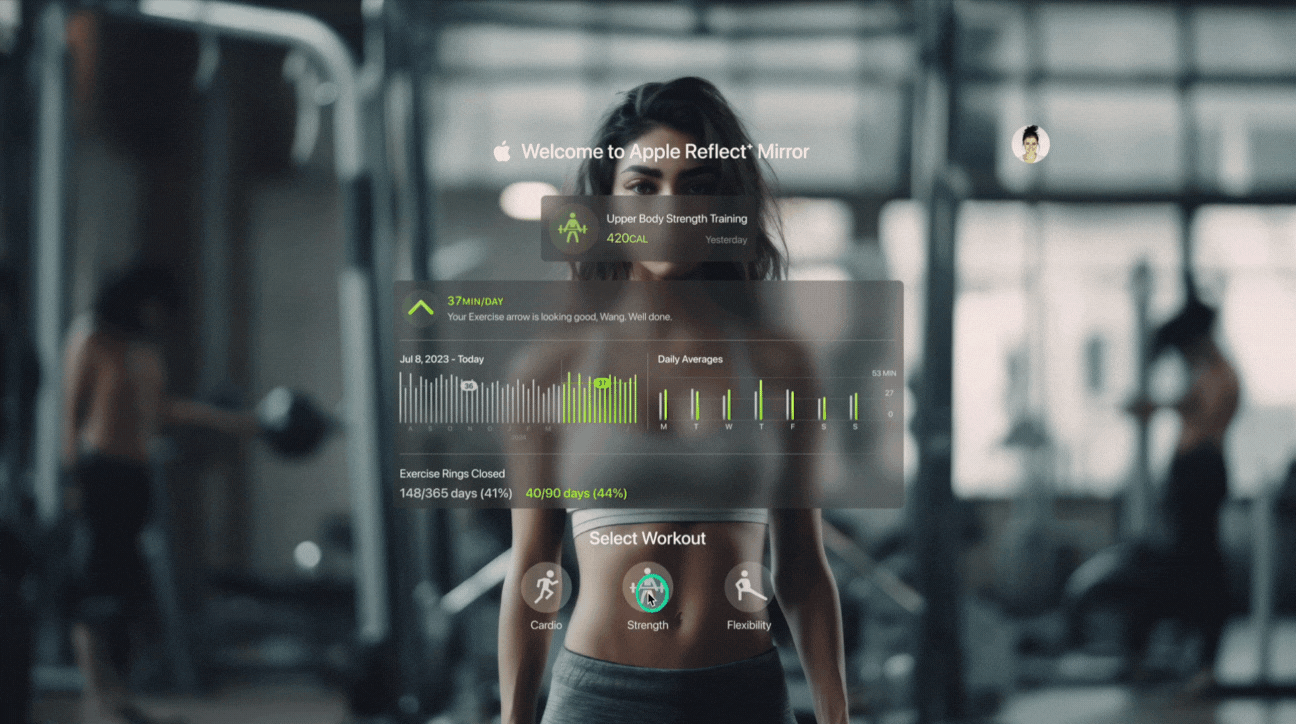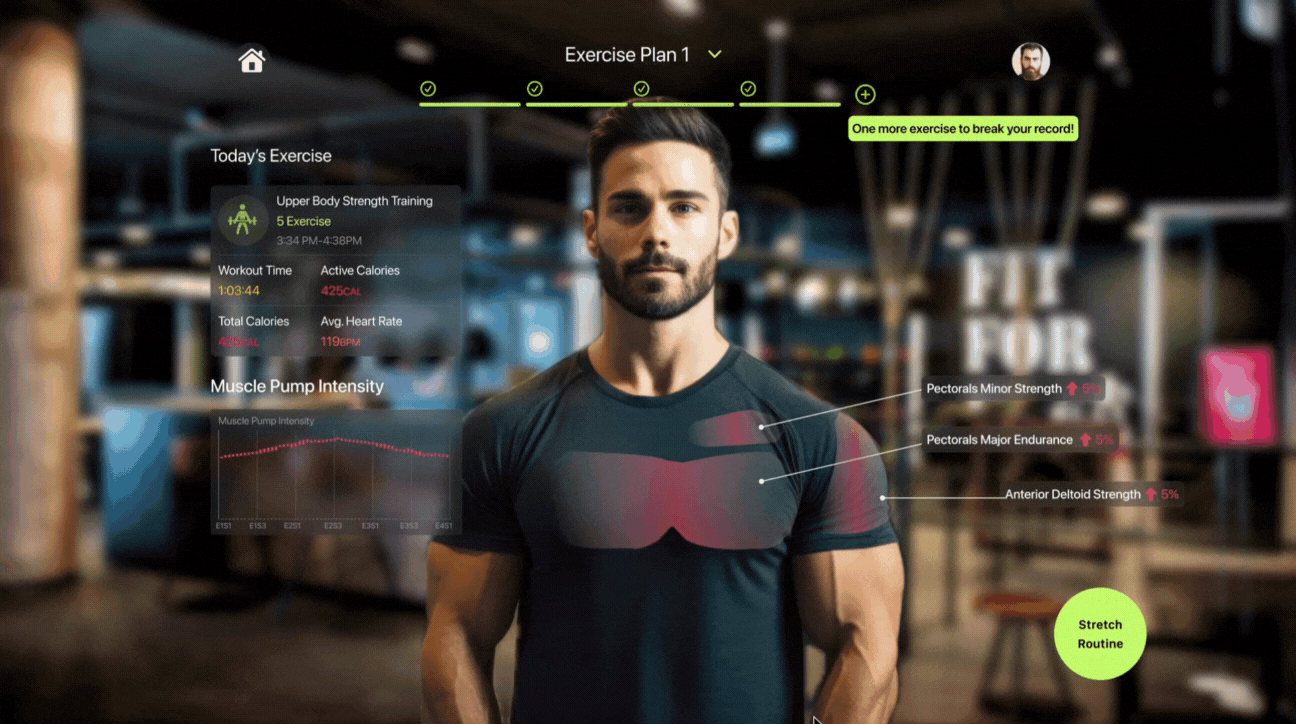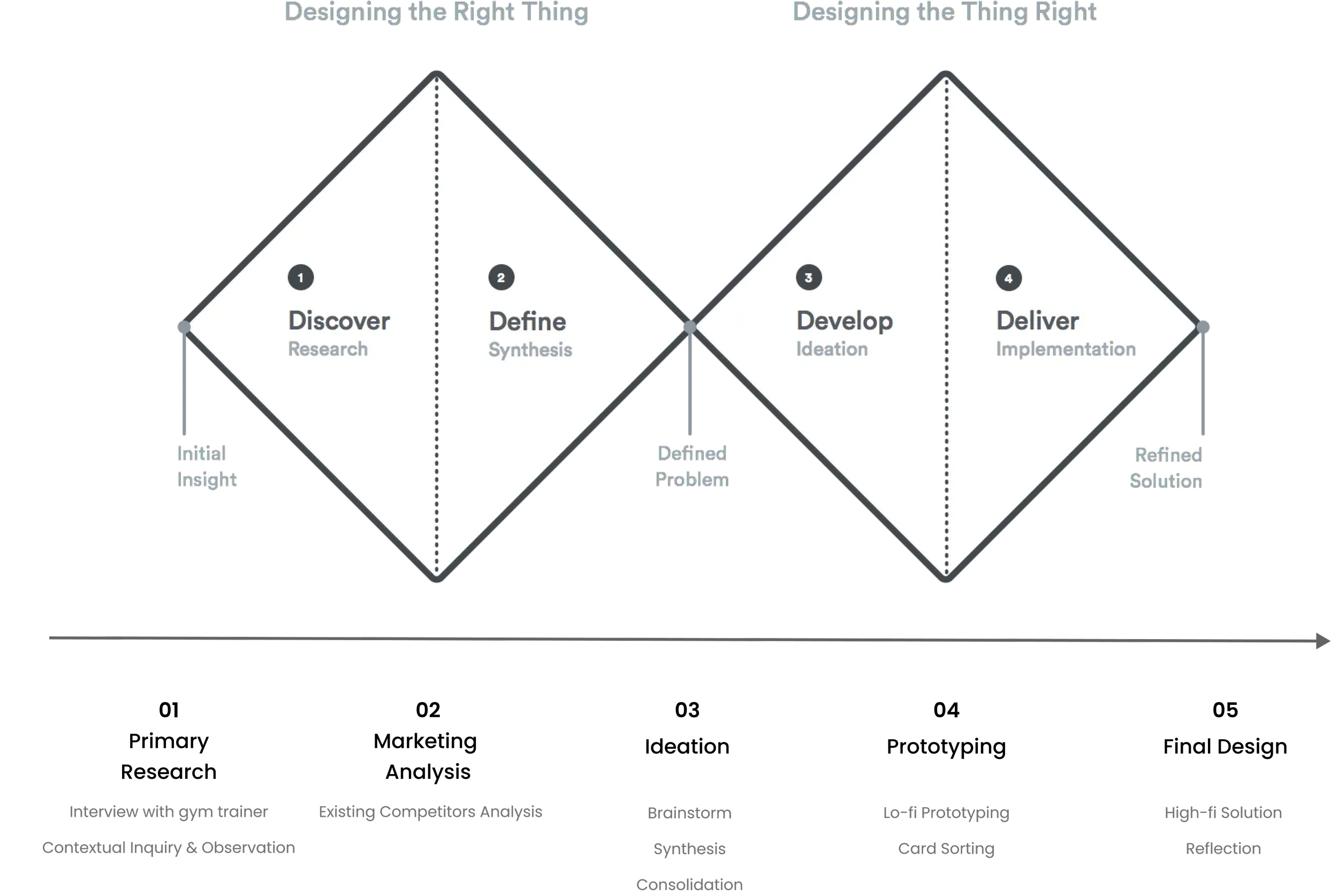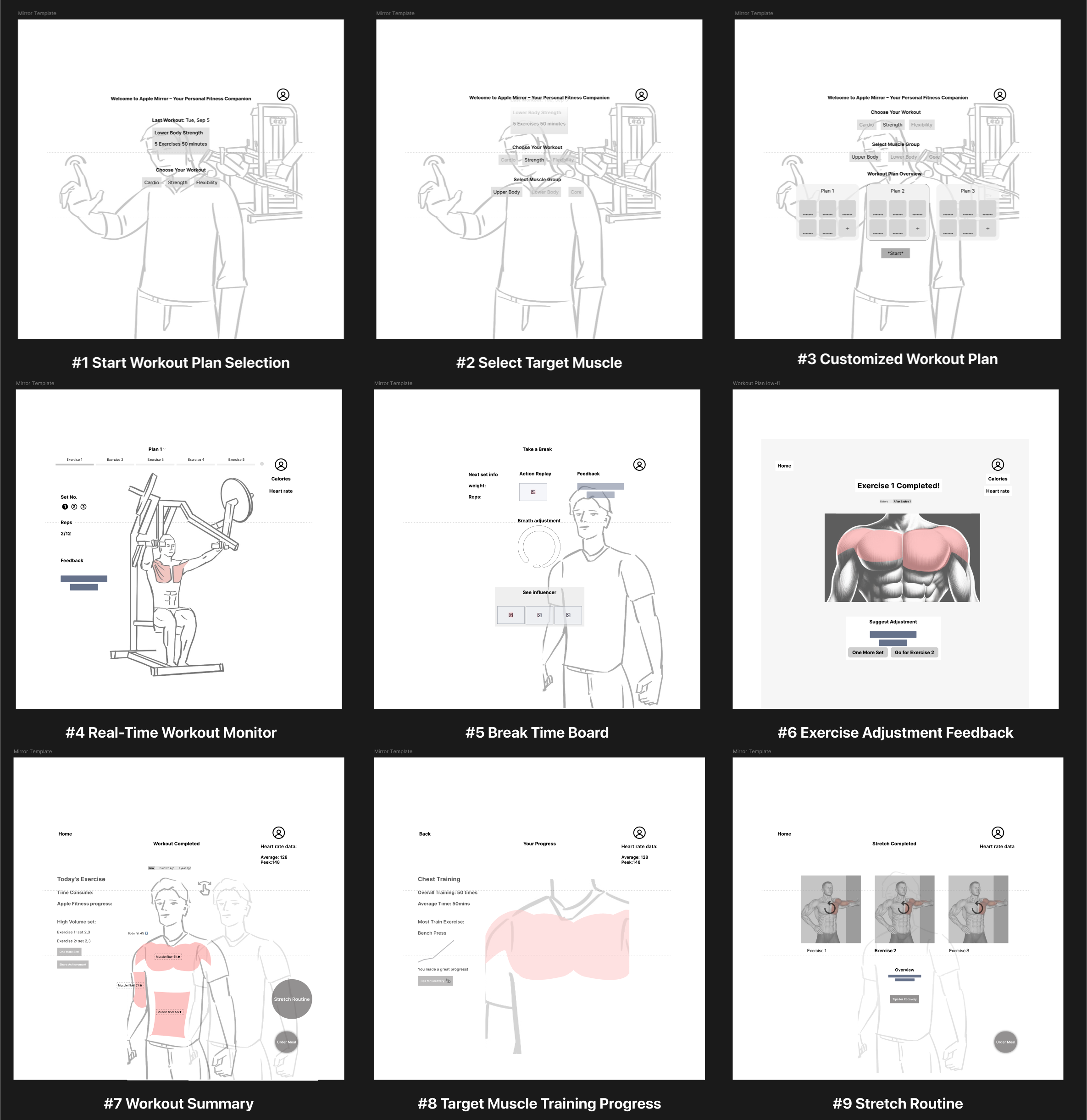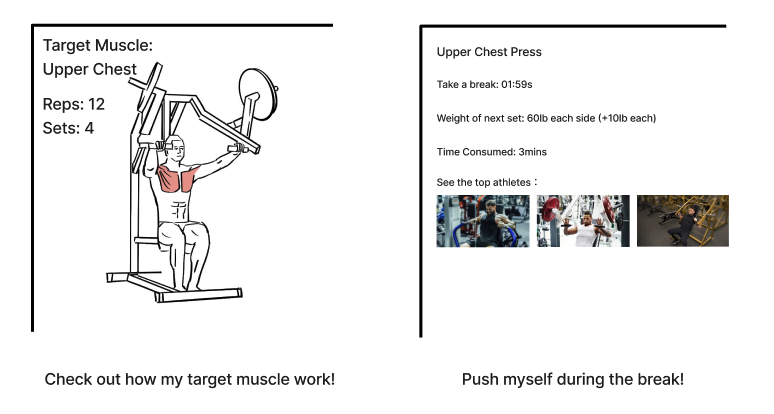Apple Reflect⁺ Mirror
UX + UI Design | Individual Work | Conceptual | 8 Weeks | Figma
Ultimate fitness companion for precision and performance, offering a personalized, interactive workout experience in real-time.
I chose the gym mirror as the core medium because it is an ambient object that blends seamlessly into the workout environment. The Apple Reflect⁺ Mirror transforms this familiar tool into an intelligent assistant, providing hands-free, real-time progress tracking and intuitive guidance, bridging innovative concepts with practical user needs.
Project Overview
1.1 Track progress at homepage
2. 1 Real-time feedback highlights active muscles and corrects form with AI prompts
2. 2 During breaks, show health data, preview the next set, and quick trainer videos for guidance and motivation.
3.1 Post-workout, summarizes performance and offers muscle-specific progress insights.
3.3 Stretch Routine with AI prompt
4.1 Order personalized meals with detailed nutrition info
4.2 Upload data to your tracker.
Problem Statement
The fitness industry has grown significantly. As a fitness enthusiast with 10 years of experience, I train at the gym five times weekly. Both beginners and seasoned athletes struggle to assess muscle training effectiveness accurately.
“Why don’t I feel this exercise working?”
“Which muscle group is this exercise targeting?”
Those questions showing remain unaware of form or technique mistakes, leading to injuries—this lack of real-time feedback results in inefficient or harmful training practices.
Design Process
I engaged with key stakeholders throughout the project by conducting primary research, followed by ideation, prototyping, and iterative usability testing. This approach was focused on deeply understanding the target users and addressing their specific needs.
01. Interview Findings
I conducted multiple one-on-one exploratory interviews to gain deeper insights into the thought processes, motivations, satisfaction points, and frustrations of gym users. These interviews aimed to uncover users' mental landscapes by engaging in in-depth discussions with a diverse yet targeted sample of five participants.
💡Insight 1
Without a clear visualization of progress, users find it hard to track improvements or know when to adjust their workout plans to achieve their fitness goals.
💡Insight 2
Relying on self-education and observation to navigate gym equipment and improve fitness can lead to slower progress and increased frustration.
💡Insight 3
Users struggle to accurately assess which muscles are being targeted during workouts, leading to ineffective exercises and potential imbalances.
💡Insight 4
Users often abandon fitness apps due to overly complex features that require time-consuming data entry and selection. Once they become familiar with the data, such as workout plans or calorie tracking, they lose interest and stop using the apps.
Interviews with Personal Trainer
In addition to speaking with Gym users, I spoke with 1 personal trainer to understand his point of view.
💡Insight 5
Frequently encounter difficulties in keeping clients motivated throughout their fitness journey, particularly when clients hit plateaus or become bored with their routines.
💡Insight 6
While the trainer sees the value in tech tools, they often find it challenging to integrate these into their sessions without disrupting the flow or becoming too dependent on the technology.
02. Marketing Analysis
I also conducted market research and analyzed existing workout products, including mobile apps, AI-based solutions, services, and fitness mirrors. I prioritized the potential features, visualized them, and integrated them into a cohesive design.
Key takeaways
⭐️ Mobile Apps (myfitnesspal, Aaptiv, Apple Fitness, Google Fit, etc)
Most Fitness have workout plan exploration and most are home workout videos.
Meal tracking includes taking photos and barcode scanning.
Too many functions & info, which needs users to take their phones every moment.
Track progress always using weekly, but there are mostly 5-split training and 3-split training for gym users.
Smart Mirror (Lululemon, Tonal, Tempo, etc)
While providing robust features, they lack integration with a broader tech ecosystem, potentially leading to fragmented user experiences.
Offer AI features; however, the depth and personalization may not match users’ needs.
Focus primarily on workout sessions, often lacking comprehensive recovery and nutrition guidance.
Some models, like Tonal, require wall mounting and professional installation, which may not suit all users or living spaces.
03. Product Opportunity
The key insights from my research led me to the following opportunity statement:
💡“How might we help fitness non-professionals set & adjust their workout goals, and easily record& understand the workout progress?”
Translation into Product Requirements
Based on prior research and interviews, I list the following product requirements in order of priority.
Provide Clear and Customizable Workout Goals
Real-Time Progress Monitoring and Feedback
Simplified Tracking of Workout Data
User-Friendly Interface with Guided Assistance
Comprehensive Post-Workout Analysis
04. Ideation
Once the consumer values and product requirements were defined, the ideation and conceptualization phase began. The process started with open brainstorming, embracing all ideas, including unconventional ones, as potential sources of innovation. These ideas were then categorized and refined, before being evaluated against specific criteria to identify and develop the final concept.
Ⅰ. Brainstorming
The ideation process began with generating more than 20 ideas centered around my product requirements, including but not limited to features, potential technologies, mediums, and services.
Ⅱ. Affinity Grouping
Then these ideas were grouped into categories.
Ⅲ. Rapid “Pretotyping” and Synthesis
Then these ideas were grouped into categories.
I extracted key elements from the ideation phase and swiftly created pre-prototypes for potential solutions. By employing storyboards and wireframes, the ideas were more effectively aligned with the intended values, making them easier to visualize and assess. This approach proved invaluable in evaluating their feasibility.
Ⅳ. User Feedback
I took these ideas talk to fitness non-professionals to gather their insights and feedback. These were more focused on understanding if my target users found value in the idea of fulfilling their needs.
Users appreciate "real-time" exercise feedback and suggestions but are uncertain about the best medium to deliver this experience. Current products like fitness watches, mobile phones, and ear pods need to meet their needs within this context fully.
Users are excited about AI-generated adjustments based on workout progress, appreciating the potential for clear guidance. However, they express concerns about whether the AI can truly meet their individual needs and accurately assess the effort they’ve put in.
Users find the concept of visualizing muscle engagement during workouts intriguing, especially to understand better which muscles are being targeted. However, they question the accuracy of this feature and whether it can effectively highlight imbalances or underdeveloped areas.
Users are enthusiastic about having detailed post-workout analytics, especially if it includes insights into muscle fatigue, recovery needs, and overall progress. However, they wonder if the data provided will be too overwhelming or if it will be presented in a way that is easy to interpret and actionable.
Ⅴ. Consolidation
Inspired by user feedback, I chose the gym mirror as the central medium for its accessibility and frequent use. It frees users’ hands while effectively visualizing workout progress, guiding the development of key features, and turning concepts into reality.
Storyboard & Userflow
05. Prototyping and Testing
I better understood what users needed through the ideation phase, which guided me in prototyping and testing. I had one round iteration for both low and high-fidelity testing.
Low Fidelity Prototyping
The low-fidelity prototype aims to show the main features and user flows for Pre-workout, During-workout, and Post-workout stages. This prototype enabled me to conduct the first round of testing, providing better navigation and usability insights for users.
1st Round Testing & Iteration
I conducted testing with several gym users to gather feedback on the features and user flows. This session provided constructive feedback and valuable insights.
Onboarding Screen Experience
Users needed more guidance and context when first encountering the screen. They suggested additional navigation options or information displaying their workout history and progress could provide better references when selecting a workout plan.
Mirror Interface & Mirror Area Balance
Users expressed concerns about the potential impact of the real-time monitoring interface on their sightlines during workouts. They were also worried that the abundance of data displayed on the mirror could be overwhelming, leading to confusion or difficulty in focusing on their workout.
Incorporating Apple Design System
During the first iteration, I experimented with incorporating elements of the Apple Design System into the Apple Mirror interface. This approach allowed me to explore how well this design style would resonate with users and assess its suitability within the overall user experience. I was eager to see how the users would interact with this refined design and whether it would enhance their workout experience.
2nd Round Testing & Iteration
Following the first round of iteration, I solidified the design style and visualization approach for the mirror's interface. I utilized a pre-built prototype to simulate a live experience with target users. Based on the observations and notes gathered during these sessions, I refined and iterated on the medium-fidelity screens.
Include history and training progress before selecting a workout plan to provide users with better reference and motivation. Enhance user guidance with subtle fade-in and fade-out visual effects.
Optimized the UI colors and visual elements (Feedback prompt, buttons, etc), making it more suitable for the digital mirror and deepening the user's sense of immersion. Simplified the display of certain training progress data, emphasizing buttons and text prompts to catch the user's attention. The goal was to enhance guidance, making it easier for users to navigate and proceed to the next step.
Improved the overall layout of the interface and optimized visual modules to help users focus on key information.
Hi-fi Design
-Feature 1/ Workout Progress & Plan Setting-
The first step guides users through their training progress and history, highlighting achievements and areas for improvement. The system then suggests three personalized workout plans, with customized options to fit user goals and preferences.
-Feature 2/ Real-Time Workout Monitor-
The mirror displays real-time data once users start their session and offer continuous support. For tough sets, it provides motivational prompts to push limits. Between sets, it helps regulate breathing, ensures proper rest, and prepares users for the next round.
-Feature 3/ Post-Workout Summary and Stretch Routine-
After the workout, users receive a summary with key metrics like performance, muscle activation, and progress. They can review muscle-specific data and compare improvements. During cooldown, the mirror guides targeted stretches with animations for recovery and recommends a post-workout meal with quick nutrition logging.
-Feature 4/ Workout Meal Order and Nutrition Recording-
Users can easily order a post-workout meal through the Apple Mirror, browsing options based on their dietary needs and calorie goals. Each meal includes detailed nutritional info to support informed choices. Users can also log their meal data directly into their diet tracker, keeping fitness and nutrition seamlessly connected.
Next Step
For the next step, I plan to prioritize accessibility to ensure the design accommodates a wide range of users, including beginners, individuals with disabilities, and those less familiar with technology. Potential features to explore include voice commands and gesture-based controls for a more intuitive and inclusive user experience.
Building a sense of community will also be a major focus. Features such as collaborative workouts, challenges, and achievements can encourage users to connect with trainers or friends, fostering motivation and engagement through shared experiences.
Additionally, I aim to expand the role of AI beyond the traditional chat-box interface. As a product designer, I’m excited to explore alternative AI-driven interactions, such as immersive AI coaches that provide real-time guidance and adaptive feedback. This approach can redefine how users engage with AI, delivering a richer, more dynamic workout experience.

